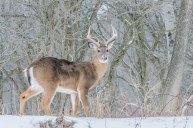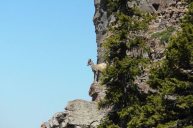North Dakota's bighorn sheep population is the lowest it's been since 2006.
The North Dakota Game and Fish Department recently completed and compiled its annual bighorn sheep survey for 2017. The agency released its findings in an email newsletter.
They concluded that the sheep population has declined from the year before, with an 11 percent drop over 2016 in the western herd, and a 9 percent decline below the five-year average.
The northern badlands population showed a 10 percent decline from 2016, and the southern badlands indicated a disturbing 21 percent drop.
The drop in numbers is a dramatic turn of events, considering that the 2014 northern badlands count was the highest on record. The southern badlands, however, showed a 15 percent decline the same year.
The survey count was the lowest it's been since 2006.
The decline has biologists concerned over the long-term health of bighorn herds in the state. North Dakota big game biologist Brett Wiedmann stated that bacterial pneumonia is behind the drop in numbers.
"The decline in the 2017 count reflects the spread of bacterial pneumonia to three previously unaffected herds and consequently the adult and lamb mortalities that followed," Wiedmann said.
Biologists counted 91 rams, 149 ewes and 25 lambs in western North Dakota, but did not include 20 to 30 bighorns in the North Unit of Theodore Roosevelt National Park.
Some good news
There was, however, a bit of hopeful news to the overall sheep population decline. "Fortunately, adult mortality was low in previously affected herds," according to Wiedmann, "and lamb survival improved as well, which could indicate those herds initially exposed to the deadly pathogens in 2014 are beginning to recover. The next few years will be important in determining if the state's population shows signs of recovering from the disease outbreak, or if the pathogens are likely to persist and cause a long-term population decline."
"The total count of adult rams and ewes was much lower than the record high counts in 2016," he continued, "but the lamb count and recruitment rate improved slightly in 2017, albeit still much below the long-term averages."
The sheep survey is a two-part process, with biologists counting and classifying the animals in late summer, before recounting the lambs the following March. The lambs determine recruitment numbers. If most of them are still around as they approach one year of age, then recruitment is good.
Each year between 8,000 and 10,000 hunters apply for only four or five allotted bighorn tags. Last year all five hunters filled their tags.
Barring a recurrence of significant adult mortality from bacterial pneumonia, the 2018 bighorn sheep season and number of tags issued will be determined Sept. 1. In 2014 an outbreak of bacterial pneumonia closed the North Dakota sheep hunting season.
Like what you see here? You can read more great articles by David Smith at his facebook page, Stumpjack Outdoors.
NEXT: 20,000 Acres of North Dakota Hunting Habitat Accessible Thanks to Private Rancher
WATCH




